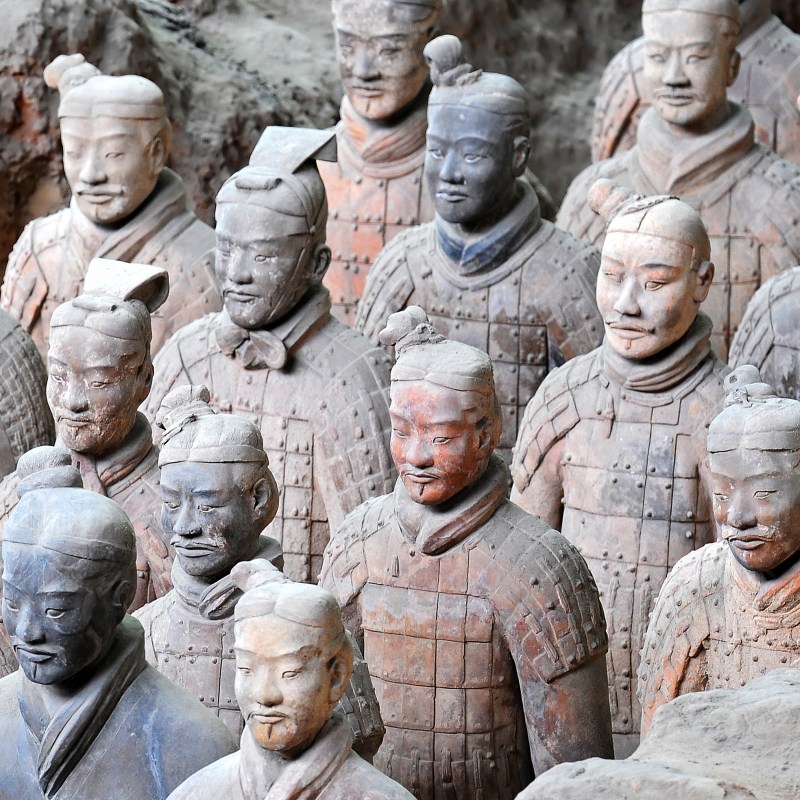
They are the incredible, mysterious tomb guardians of a long-dead Chinese emperor, and their discovery in the 1970s made global headlines. Xi’an’s terra-cotta warriors are incredible, and some 40 years after their discovery, archeologists still haven’t uncovered all of their secrets.
Videos by TravelAwaits
Here are five fascinating facts about the ancient life-size sentinels — and some things to keep in mind if you decide to make the trip to see them.

1. Emperor Qin Shi Huang Ordered Them Built
Emperor Qin Shi Huang was the powerful first-ever unifier of China. As befitted a royal of his status, he wanted to make sure he had plenty of company in the afterlife. According to historic records from the time, Emperor Qin ordered thousands of workers to construct the underground army complex, and he was buried in it when he died in 210 B.C. While Emperor Qin’s remains have not yet been found, there are an estimated 8,000 soldiers, 670 horses, and 130 chariots in his mausoleum, all constructed of terra-cotta, in the massive underground pit. Only a fraction of the figures have been uncovered.

2. Each Figure Is Different
The thousands of workers who crafted the army did so with painstaking attention to detail. While scientists believe each figure started as a mold — a factory-line approach — the soldiers have different facial characteristics and expressions. They’re wearing different clothes, and their hair is styled in various ways. Even their body types vary: Some are slender; others not so much! The level of artistic skill involved is evident, especially when you consider that each figure is different from his fellow soldiers.

3. The Army Was Discovered By Mistake
The entire tomb complex had been buried for millennia when, in April of 1974, farmers digging a well outside of Xi’an unearthed several pottery heads and bronze weapons. Chinese scientists were immediately called to the scene, and what they began to uncover stunned archeologists the world over. Just a year after the discovery, the Chinese government decided to build a museum on the site. In 1987, the mausoleum complex was named a UNESCO World Heritage site.

4. Excavations Are Ongoing
When scientists realized exactly what had been discovered, and the scope of the three massive artifact fields, they took a drastic preservation step. The bunkers that allow visitors to see the pits were constructed right over the dig sites in order to keep out the elements and allow archeologists to continue to sift through the pits. Their work continues today, and it’s estimated that thousands of statues remain buried. If you look closely inside the pits, you’ll see the tools of their trade.

5. The Figures Were Once Quite Colorful
While they are a faded gray color now, the warriors were once quite colorful. Recent research has found that each soldier, horse, and weapon was painted by hand. However, when scientists started to unearth the warriors in the 1970s, they were horrified when the rich, glossy black, blue, purple, green, and yellow hues faded right before their eyes. The pigment — thousands of years old and previously protected underground — couldn’t stand up to the air and simply evaporated. Today, scientists are trying to determine the exact composition of the paint in the hope of one day restoring the army to its former multihued glory. For now, the warriors stand ready to fight — and await their makeover.

What To Know Before You Go
When we entered the first pit’s bunker and saw the sheer size and scope of the army, we were absolutely astounded. It looked like a cross between a scene from an Indiana Jones movie and the front page of National Geographic. Emperor Qin’s tomb is an iconic site, and when you stand before these ancient statues, you’ll hardly believe your eyes. Yes, it will likely be crowded, and you’ll have to angle a bit for the perfect snaps and selfies. But getting a feel for the sheer magnitude of the place — in person — is priceless.
If you are lucky enough to travel to this bucket-list destination, don’t make the same mistake we did: Hang on to your admission ticket stub. You will need it to enter two additional turnstiles before you access the pits where the warriors can be viewed. Throw it away or misplace it, and you’ll have to go all the way back to the entrance and pay for another ticket. Full disclosure: Seeing the warriors was absolutely worth the double price!
While the soldiers are the headline attraction in Xi’an, there are many other things to see and do in this fascinating city. Here are just a few.
